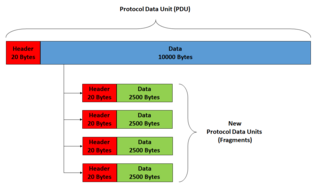Related Research Articles
The Internet Control Message Protocol (ICMP) is a supporting protocol in the Internet protocol suite. It is used by network devices, including routers, to send error messages and operational information indicating success or failure when communicating with another IP address. For example, an error is indicated when a requested service is not available or that a host or router could not be reached. ICMP differs from transport protocols such as TCP and UDP in that it is not typically used to exchange data between systems, nor is it regularly employed by end-user network applications.

Internet Protocol version 4 (IPv4) is the fourth version of the Internet Protocol (IP). It is one of the core protocols of standards-based internetworking methods in the Internet and other packet-switched networks. IPv4 was the first version deployed for production on SATNET in 1982 and on the ARPANET in January 1983. It is still used to route most Internet traffic today, even with the ongoing deployment of Internet Protocol version 6 (IPv6), its successor.

Internet Protocol version 6 (IPv6) is the most recent version of the Internet Protocol (IP), the communications protocol that provides an identification and location system for computers on networks and routes traffic across the Internet. IPv6 was developed by the Internet Engineering Task Force (IETF) to deal with the long-anticipated problem of IPv4 address exhaustion, and was intended to replace IPv4. In December 1998, IPv6 became a Draft Standard for the IETF, which subsequently ratified it as an Internet Standard on 14 July 2017.
The Internet Protocol (IP) is the network layer communications protocol in the Internet protocol suite for relaying datagrams across network boundaries. Its routing function enables internetworking, and essentially establishes the Internet.
Multiprotocol Label Switching (MPLS) is a routing technique in telecommunications networks that directs data from one node to the next based on labels rather than network addresses. Whereas network addresses identify endpoints, the labels identify established paths between endpoints. MPLS can encapsulate packets of various network protocols, hence the multiprotocol component of the name. MPLS supports a range of access technologies, including T1/E1, ATM, Frame Relay, and DSL.
In computer networking, the maximum transmission unit (MTU) is the size of the largest protocol data unit (PDU) that can be communicated in a single network layer transaction. The MTU relates to, but is not identical to the maximum frame size that can be transported on the data link layer, e.g., Ethernet frame.
The Transmission Control Protocol (TCP) is one of the main protocols of the Internet protocol suite. It originated in the initial network implementation in which it complemented the Internet Protocol (IP). Therefore, the entire suite is commonly referred to as TCP/IP. TCP provides reliable, ordered, and error-checked delivery of a stream of octets (bytes) between applications running on hosts communicating via an IP network. Major internet applications such as the World Wide Web, email, remote administration, and file transfer rely on TCP, which is part of the Transport layer of the TCP/IP suite. SSL/TLS often runs on top of TCP.
In computer networking, the User Datagram Protocol (UDP) is one of the core communication protocols of the Internet protocol suite used to send messages to other hosts on an Internet Protocol (IP) network. Within an IP network, UDP does not require prior communication to set up communication channels or data paths.
In computing, Internet Protocol Security (IPsec) is a secure network protocol suite that authenticates and encrypts packets of data to provide secure encrypted communication between two computers over an Internet Protocol network. It is used in virtual private networks (VPNs).

IP fragmentation is an Internet Protocol (IP) process that breaks packets into smaller pieces (fragments), so that the resulting pieces can pass through a link with a smaller maximum transmission unit (MTU) than the original packet size. The fragments are reassembled by the receiving host.
The maximum segment size (MSS) is a parameter of the Options field of the TCP header that specifies the largest amount of data, specified in bytes, that a computer or communications device can receive in a single TCP segment. It does not count the TCP header or the IP header. The IP datagram containing a TCP segment may be self-contained within a single packet, or it may be reconstructed from several fragmented pieces; either way, the MSS limit applies to the total amount of data contained in the final, reconstructed TCP segment.
The Neighbor Discovery Protocol (NDP), or simply Neighbor Discovery (ND), is a protocol of the Internet protocol suite used with Internet Protocol Version 6 (IPv6). It operates at the internet layer of the Internet model, and is responsible for gathering various information required for network communication, including the configuration of local connections and the domain name servers and gateways.
A ping of death is a type of attack on a computer system that involves sending a malformed or otherwise malicious ping to a computer. In this attack, a host sends hundreds of ping requests with a packet size that is large or illegal to another host to try to take it offline or to keep it preoccupied responding with ICMP Echo replies.
In packet-switched computer networks, a jumbogram is an internet-layer packet exceeding the standard maximum transmission unit (MTU) of the underlying network technology. In contrast, large packets for link-layer technologies are referred to as jumbo frames.
Internet Control Message Protocol version 6 (ICMPv6) is the implementation of the Internet Control Message Protocol (ICMP) for Internet Protocol version 6 (IPv6). ICMPv6 is an integral part of IPv6 and performs error reporting and diagnostic functions.
6LoWPAN was a working group of the Internet Engineering Task Force (IETF). It was created with the intention of applying the Internet Protocol (IP) even to the smallest devices, enabling low-power devices with limited processing capabilities to participate in the Internet of Things.
Path MTU Discovery (PMTUD) is a standardized technique in computer networking for determining the maximum transmission unit (MTU) size on the network path between two Internet Protocol (IP) hosts, usually with the goal of avoiding IP fragmentation. PMTUD was originally intended for routers in Internet Protocol Version 4 (IPv4). However, all modern operating systems use it on endpoints. In IPv6, this function has been explicitly delegated to the end points of a communications session. As an extension to the standard path MTU discovery, a technique called Packetization Layer Path MTU Discovery works without support from ICMP.
The internet layer is a group of internetworking methods, protocols, and specifications in the Internet protocol suite that are used to transport network packets from the originating host across network boundaries; if necessary, to the destination host specified by an IP address. The internet layer derives its name from its function facilitating internetworking, which is the concept of connecting multiple networks with each other through gateways.
The Internet checksum, also called the IPv4 header checksum is a checksum used in version 4 of the Internet Protocol (IPv4) to detect corruption in the header of IPv4 packets. It is carried in the IP packet header, and represents the 16-bit result of summation of the header words.
IPv4 Residual Deployment (4rd) is an IPv6 transition mechanism for Internet service providers for deployment of Internet Protocol version 6 (IPv6), while maintaining IPv4 service to customers. The protocol and sample applications are specified in RFC 7600.
References
- 1 2 3 4 5 6 7 8 9 10 11 12 13 S. Deering; R. Hinden (July 2017). Internet Protocol, Version 6 (IPv6) Specification. IETF. doi: 10.17487/RFC8200 . STD 86. RFC 8200.Internet Standard 86. Obsoletes RFC 2460.
- ↑ K. Nichols; S. Blake; F. Baker; D. Black (December 1998). Definition of the Differentiated Services Field (DS Field) in the IPv4 and IPv6 Headers. Network Working Group. doi: 10.17487/RFC2474 . RFC 2474.Proposed Standard. Obsoletes RFC 1455 and 1349. Updated by RFC 3168, 3260 and 8436.
- ↑ D. Grossman (April 2002). New Terminology and Clarifications for DiffServ. doi: 10.17487/RFC3260 . RFC 3260.Informational. Updates RFC 2474, 2475 and 2597.
- 1 2 3 B. Fenner (November 2006). Experimental Values in IPv4, IPv6, ICMPv4, ICMPv6, UDP, and TCP Headers. Network Working Group. doi: 10.17487/RFC4727 . RFC 4727.Proposed Standard.
- ↑ K. Ramakrishnan; S. Floyd; D. Black (September 2001). The Addition of Explicit Congestion Notification (ECN) to IP. Network Working Group. doi: 10.17487/RFC3168 . RFC 3168.Proposed Standard. Obsoletes RFC 2481. Updates RFC 2474, 2401 and 793. Updated by RFC 4301, 6040 and 8311.
- ↑ S. Amante; B. Carpenter; S. Jiang; J. Rajahalme (November 2011). IPv6 Flow Label Specification. IETF. doi: 10.17487/RFC6437 . ISSN 2070-1721. RFC 6437.Proposed Standard. Obsoletes RFC 3697. Updates RFC 2205 and 2460.
- ↑ Use of the IPv6 Flow Label as a Transport-Layer Nonce to Defend Against Off-Path Spoofing Attacks
- 1 2 3 D. Borman; S. Deering; R. Hinden (August 1999). IPv6 Jumbograms. Network Working Group. doi: 10.17487/RFC2675 . RFC 2675.Proposed Standard. Obsoletes RFC 2147.
- ↑ C. Partridge; F. Kastenholz (December 1994). Technical Criteria for Choosing IP The Next Generation (IPng). Network Working Group. doi: 10.17487/RFC1726 . RFC 1726.Informational. sec. 2.6.
- ↑ T. Heer; P. Jokela; T. Henderson (April 2015). R. Moskowitz (ed.). Host Identity Protocol Version 2 (HIPv2). Internet Engineering Task Force (IETF). doi: 10.17487/RFC7401 . ISSN 2070-1721. RFC 7401.Proposed Standard. Obsoletes RFC 5201. Updated by RFC 8002 and 9374.
- ↑ E. Nordmark; M. Bagnulo (June 2009). Shim6: Level 3 Multihoming Shim Protocol for IPv6. Networking Working Group. doi: 10.17487/RFC5533 . RFC 5533.Proposed Standard.
- 1 2 3 4 T. Narten (January 2004). Assigning Experimental and Testing Numbers Considered Useful. Network Working Group. doi: 10.17487/RFC3692 . BCP 82. RFC 3692.Best Common Practice. Updates RFC 2434.
- ↑ "Internet Protocol Version 6 (IPv6) Parameters: Routing Types". IANA . Retrieved 2021-10-15.
- ↑ Philippe Biondi, Arnoud Ebalard (April 2007). "IPv6 Routing Header Security" (PDF). EADS . Retrieved 3 December 2010.
Type 0: the evil mechanism...
- ↑ J. Abley; P. Savola; G. Neville-Neil (December 2007). Deprecation of Type 0 Routing Headers in IPv6. doi: 10.17487/RFC5095 . RFC 5095.Draft Standard. Updates RFC 2460 and 4294.
- ↑ I. Castineyra; N. Chiappa; M. Steenstrup (August 1996). The Nimrod Routing Architecture. doi: 10.17487/RFC1992 . RFC 1992.Informational.
- ↑ J. Hui; JP. Vasseur; D. Culler; V. Manral (March 2012). An IPv6 Routing Header for Source Routes with the Routing Protocol for Low-Power and Lossy Networks (RPL). Internet Engineering Task Force. doi: 10.17487/RFC6554 . RFC 6554.Proposed Standard.
- ↑ S. Previdi; J. Leddy; S. Matsushima; D. Voyer (March 2020). C. Filsfils; D. Dukes (eds.). IPv6 Segment Routing Header (SRH). Internet Engineering Task Force (IETF). doi: 10.17487/RFC8754 . ISSN 2070-1721. RFC 8754.Proposed Standard.
- ↑ S. Kent (December 2005). IP Authentication Header. Network Working Group. doi: 10.17487/RFC4302 . RFC 4302.Proposed Standard. Obsoletes RFC 2402.
- ↑ S. Kent (December 2005). IP Encapsulating Security Payload. Network Working Group. doi: 10.17487/RFC4303 . RFC 4303.Proposed Standard. Obsoletes RFC 2406.
- 1 2 F. Gont; V. Manral; R. Bonica (January 2014). Implications of Oversized IPv6 Header Chains. IETF. doi: 10.17487/RFC7112 . ISSN 2070-1721. RFC 7112.Proposed Standard. Updates RFC 2460.
- ↑ F. Gont (February 2014). Implementation Advice for IPv6 Router Advertisement Guard (RA-Guard). IETF. doi: 10.17487/RFC7113 . ISSN 2070-1721. RFC 7113.Informational. Updates RFC 6105.
- ↑ F. Gont (August 2013). Security Implications of IPv6 Fragmentation with IPv6 Neighbor Discovery. IETF. doi: 10.17487/RFC6980 . ISSN 2070-1721. RFC 6980.Proposed Standard. Updates RFC 3971 and 4861.